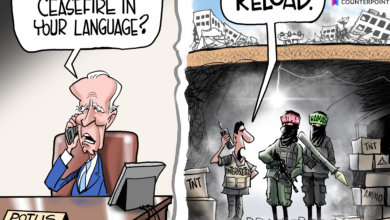Rebutting John Mearsheimer: China’s Military Is NOT Inferior To That Of The US
Satellite photos of the entrances to China’s secret, underground submarine bases in Sanya (Hainan Island) and Jianggezhuang (near Qingdao). Photo credit: Federation of American Scientists and Google Earth.
In a recent article for the “National Interest” magazine, UChicago professor John Mearsheimer, who is best known for advocating that the US dump Israel as an ally, falsely claims that “China’s military is inferior to that of the US, and not by a small margin.”
Mearsheimer gives no reason whatsoever for why he makes such an outlandish claim; he does so probably because of longstanding (and badly outdated) assumptions about China’s military still prevailing in Washington. Be that as it may, Mearsheimer is dead wrong. Period.
For the PLA (the Chinese military) is not inferior to the US military in ANYTHING.
Not in training – Chinese troops train as hard as their American counterparts, and women in the PLA get no special treatment or lower standards – UNLIKE the US military, where women have to complete tasks that even the weakest man could accomplish. And unlike the US military, the PLA is not plagued by LGBT celebration, feminism, political correctness, or a plague of pregnancies, sexual assaults, alcoholism, and drugs.
What’s more, PLA officers do not have a standard of life significantly better than that of enlisted PLA troops, and in messes, officers and enlisted personnel eat together. Not separately. Nor is China and its PLA plagued by an obesity epidemic – again, unlike the US, where First Lady Michelle Obama’s modest efforts to combat obesity are regularly dismissed as Nanny Statism.
China’s military is also better trained – and funding for its training has never been interrupted by a stupid budgetary mechanism like sequestration. The PLA has never had to ground its aircraft for a lack of funding to fly them. PLA pilots fly and train regularly, honing their skills in their versions of Red Flag/Blue Flag exercises.
In budgetary terms, those who downplay China’s military power often claim that China has a much smaller military budget than the US.
At the first glance, this seems true: Beijing’s official military budget, unveiled a few days ago, is $132 bn, and even though China hides a lot of its military spending off the books, outside its official budget, China’s military budget is estimated to be, at most, $240 bn per annum – less than half of the $580 bn requested by the DOD for the next fiscal year.
But in China, one dollar can buy much more than in the US. China’s military budget should be multiplied by a factor of at least three to account for these differences. Multiply $240 bn by 3, and you get $720 bn. Heck, multiply $240 bn by just 2, and you get $480 bn – just slightly less than the DOD’s requested base budget for the next fiscal year ($495 bn).
Moreover, China’s military budgets are devoted mostly to equipment, training, and military operations, whereas personnel and base costs are borne largely by provincial governments, not by the central government.
China’s military is also better led than the US military, which is run by careerists eager to please their political masters, such as General Martin Dempsey and Admiral Cecil Haney. By contrast, the PLA, while nominally subordinate to the Communist Party of China, is actually THE most powerful and most cohesive faction within the Party, and is led by professional, experienced officers such as Gen. Fang Fenghui (Chief of the General Staff Department), Adm. Wu Shengli (Commander of the PLA Navy), and Gen. Ma Xiaotian (a veteran fighter pilot and Commander of the PLA Air Force).
The CPC is split into several factions that constantly battle each other for influence, and no civilian faction has a decisive edge over the others, so CPC civilians routinely ask PLA generals and admirals to support them. The generals are happy to oblige – but at a price in terms of giving them greater budgets and policymaking influence.
Hence we have seen hawkish PLA generals and senior colonels gain more influence and make increasingly inflammatory statements, and PLA budgets increase by double digits every year of the last 25 years – even now as China’s economy slows down.
Which brings me to military equipment.
China has, for the last decade and a half, been rapidly shedding obsolete Soviet-licensed and domestic equipment and rapidly acquiring domestic, Russian, and reverse-engineered weapons in large quantities – so much so that now most of its naval and air equipment is very much modern and capable, and even more modern and lethal weapons are on the way. Let’s look at some of the categories of military equipment and compare what the US and Chinese militaries have:
Fighters: The first and absolute condition of victory in any war is attaining air superiority; as Field Marshal Erwin Rommel, the famous Desert Fox, said, fighting on the ground while your enemy controls the air is pointless. The entire US military depends on air superiority, and without it, will collapse like a deck of cards.
And collapse it will, for it has inexplicably neglected its fighter fleet for the last 25 years, while China has steadily modernized its own. It now has over 200 modern, highly capable J-11 Sinoflanker fighters (pictured above) and over 200 F-16-clone J-10 fighters. In addition, it has 76 modern Su-27 and 76 also modern (and quite lethal) Su-30MKK aircraft. On top of that, it has almost 400 old, but very agile and lethal J-7 MiG fighters (which can win dogfights easily by simply refusing to be level-flying targets) and 200 J-8 high-speed, high-altitude interceptors. The PLAAF is now also beginning to receive the new J-16, another modern, high performance Chinese Flanker variant.
On the other hand, the US has fewer than 400, mostly obsolete and aging, F-15 fighters, around 1,200 non-competitive short-ranged F-16s (also largely obsolete), and around 180 modern and highly stealthy F-22 Raptors. I’m omitting the Hornets and Super Hornets of the Navy, for they aren’t even fighters but ground attack jets and wouldn’t stand a chance against PLAAF aircraft.
How exactly are PLAAF fighters superior? Owing to their combination of high speed, a high ceiling, superb radar aperture, and a large load of long-range missiles with diverse seekers, as well as high maneuverability, ease of turning and climbing, and powerful guns (30mm caliber on all Flankers).
In the future, the PLAAF will be decisively superior to the USAF. Later this decade, it will receive two very stealthy fifth-generation fighters, the J-20 and the J-31. These aircraft will render every other fighter on the planet, except the Raptor and the Russian PAK-FA, totally obsolete when they enter service.
The US, by contrast, is developing the hyper-expensive, and already obsolete, F-35 “Joint Strike Fighter”, which is not stealthy (except in the nose and only in some radar bands), poorly armed, very slow and low-flying, and too heavy and sluggish to prevail in air combat. (Nor was it ever designed, or even intended, to attain air superiority; the F-22 Raptor, of which the USAF wanted to procure 650, is supposed to accomplish that.) The defective F-35s that the DOD has ordered would, in case of any encounter with Chinese fighters, be gunned down like pigeons in a pest eradication programme.
Bases: In any war with the US in the Asia-Pacific, China would be playing on its home court; the US would be fighting a long way from the homeland. Utilizing its geographic advantage to the max, China has literally hundreds of airbases and airfields available in the mainland and in Burma. Many of these are semi-hardened, fully-hardened, or super-hardened. Many of them are located underground or built into the sides of mountains or hills. This renders these bases (i.e. the aircraft, hangars, fuel and ammunition depots, and command centers) completely immune to any US attack except with a deep earth penetrator like the GBU-57 MOP or the B83 nuclear bomb (which the Obama admin wants to retire).
All of these underground bases have entrances wide enough for J-7, J-8, J-10, Su-27, Su-30, and J-15 fighters to enter. Some of them can also accomodate the J-11, J-16, and the future J-20 and J-31. And some underground Chinese airbases can even shelter H-6 strategic bombers!
OTOH, the US has no hardened or even semi-hardened bases in the entire Pacific region. All US runways, hangars, depots, and command centers in the regions could easily be destroyed by even the weakest Chinese bombs or missiles. What’s more, the majority of US bases there are within the reach of China’s short-range ballistic missiles, and the rest can be easily reached by its medium-range ballistic and cruise missiles such as the DF-21, DF-25, DF-26, CJ/DH-10, and the Hongniao family. The newest Chinese missile, the DF-26C, has a range of at least 2200 miles (3520 kms).
Which brings me to the next category of weapons.
Land attack missiles: China, has noted above, has a huge, diverse, and highly accurate arsenal of missiles of all classes, which can be launched from ground launchers, siloes, aircraft, or ships. The longest-ranged of these, the ground-launched DH-10, has a range of 4,000 kms, the DF-26C a range of 3,520 kms, and the air-launched HN-3 a range of 3,000 kms while the air-launched CJ-10A can eke out 2,000 kms. The exact range of the DF-25 is unknown. China has huge inventories of these missiles.
By contrast, the US has no short-, medium-, or intermediate range ballistic missiles and no ground-launched cruise missiles whatsoever. The US is, in fact, prohibited from developing (let alone fielding) any ground-launched missiles of any range between 550 and 5,500 km by the INF Treaty with Russia. As one Russian official has said, it is unjust that only the US and Russia are banned from fielding such weapons, while everyone else is allowed to have them.
America’s air- and submarine-launched cruise missiles are unimpressive, to say the least. The much-touted JASSM-ER can eke out only 1,000 kms, and the sub-launched Tomahawk boasts a range of just 1,700 kms. Both of them are subsonic and thus easy for enemy air defenses to intercept.
Below you’ll find a map of the range of China’s air-launched cruise missiles. You can see it extends well beyond Guam and the Second Island Chain.
Air Defense Systems: China has a very dense network of highly-capable, long-ranged S-300 and HQ-9 air defense systems, and has even more capable S-400 systems on order. These can easily detect and shoot down any nonstealthy aircraft, including the EA-6B and the EA-18G, which, in order to attempt to jam these systems, would have to be close enough for their jammers to work – and that means TOO CLOSE to these systems, and well within their engagement envelope.
By contrast, US and allied air defense systems in the WestPac are scant and consist solely of obsolete, 1980s-vintage Patriot systems (whose range is only 28 kms) and their Japanese clones. These could be easily penetrated by any PLA aircraft or missiles.
Submarines: In addition to its growing, and increasingly quiet, fleet of nuclear-powered submarines, in which Type 093 and Type 095 class SSNs are replacing the old Type 091 Han class, the PLA Navy operates a large fleet of ultra-quiet Kilo-, Song, Yuan-, and Qin-class conventional submarines with air-independent propulsion (as in German, Swedish, and Australian submarines), making them almost undetectable.
OTOH, the US Navy has no conventional submarines and relies entirely on its noisy and obsolete Ohio class SSBNs for nuclear deterrence and also on its noisy and obsolete Los Angeles class attack submarines for sea control. The USN has only a handful of Seawolf and Virginia class submarines – and these are still noisier than conventional subs.
Mines: China has at least 100,000 naval mines – cheap, simple weapons which can cripple and sink even large warships. Yet, the US Navy is utterly unprepared for these weapons. It has only 13 minesweepers, all of which are operated by the US Naval Reserve because mine warfare is not considered a “sexy” mission by the USN, which prefers to obsess with hyper-expensive and highly vulnerable aircraft carriers – which, in today’s threat environment, are huge liabilities rather than assets.
By contrast, the much smaller UK Royal Navy has 15 minesweepers, all of which are operated by the regular RN.
Anti-ship missiles: China operates a wide range of (mostly supersonic, sea-skimming) anti-ship cruise missiles, most notably the SS-N-22 Sunburn, the SS-NX-30 Sizzler, and the Yingji family. One Sunburn missile would suffice to sink an aircraft carrier.
Also, China has fielded DF-21D anti-ship ballistic missiles with a range between 2,000 and 3,000 kms, and again, a single one would suffice to sink a flattop.
By contrast, the only anti-ship missile operated by the US military today is the under-ranged, slow, subsonic Harpoon. The USN is currently developing a replacement.
Nuclear weapons: The US currently has an edge over China in this area, with more total nuclear warheads (5,113) and deployed warheads (1,950) than China (which has up to 3,000 nuclear weapons, of which at least around 1,000 are deployed). However, China’s nuclear arsenal is rapidly growing, while the US is cutting its nuclear arsenal unilaterally. Also, China is rapidly modernizing its arsenal and making it survivable, while the US is not.
Anti-satellite weapons: This is as simple as “China has them, the US does not.” China has anti-satellite lasers as well as dozens of anti-satellite ballistic missiles, and also weapons that can jam US satellites without destroying them. China has repeatedly tested such weapons.
Small combat vessels: Chinese corvettes and missile boats, some of which are based on Australian catamarans, are better armed and better defended than the LCS, which, according to DOD weapon testers, are “not expected to survive in a combat environment.” Enough said.
Combat rifles: The US military’s standard assault rifles are the M16 and its shorter, lighter variant, the M4. Both of them are famous for their propensity to jam and malfunction. Their legendary malfunctions have cost many soldiers and Marines their lives. By contrast, China’s standard assault rifle is the simple, cheap, rugged, and supremely reliable AK-47, which will fire even if it gets dirty or even if you bury it in sand or mud. Moreover, it’s so much easier to operate that even children can use it. Furthermore, the AK-47’s 7.62 mm round can penetrate cinderblocks, bricks, and wood, while the M16’s and the M4’s smaller, weaker 5.56 mm round cannot. The Washington Times newspaper has even recently run a lengthy article detailing these rifles’ serious flaws.
I could go on and on, but the above comparisons already illustrate the point sufficiently. It is, in fact, the US military that is decisively inferior to that of China by the vast majority of criteria – from training, esprit de corps, good order, and discipline, to leadership, to the vast majority of weapon categories.
In a confrontation with the PLA, the US military would be like a virgin during her first night. Easy.
The American people need to stop listening to those who want to lull them into a false sense of security and start demanding that Congress a) fund the US military sufficiently, and b) spend the money in the most efficient way possible, with the least amount possible going to bloated personnel benefits programs and unneeded bases, and the maximum amount going to new weaponry and to training the troops.






